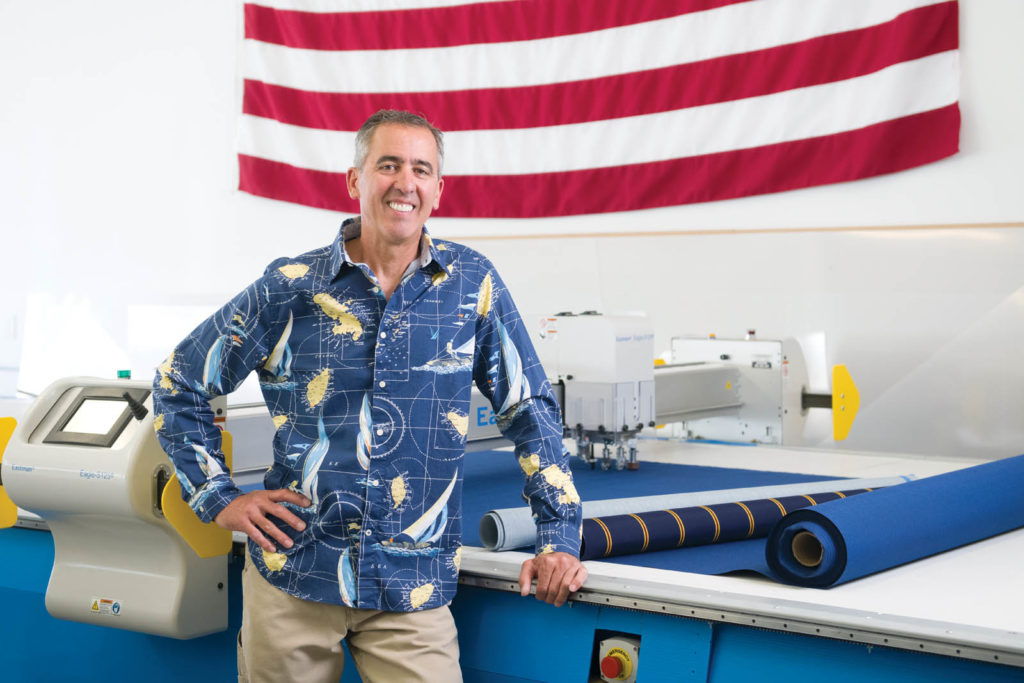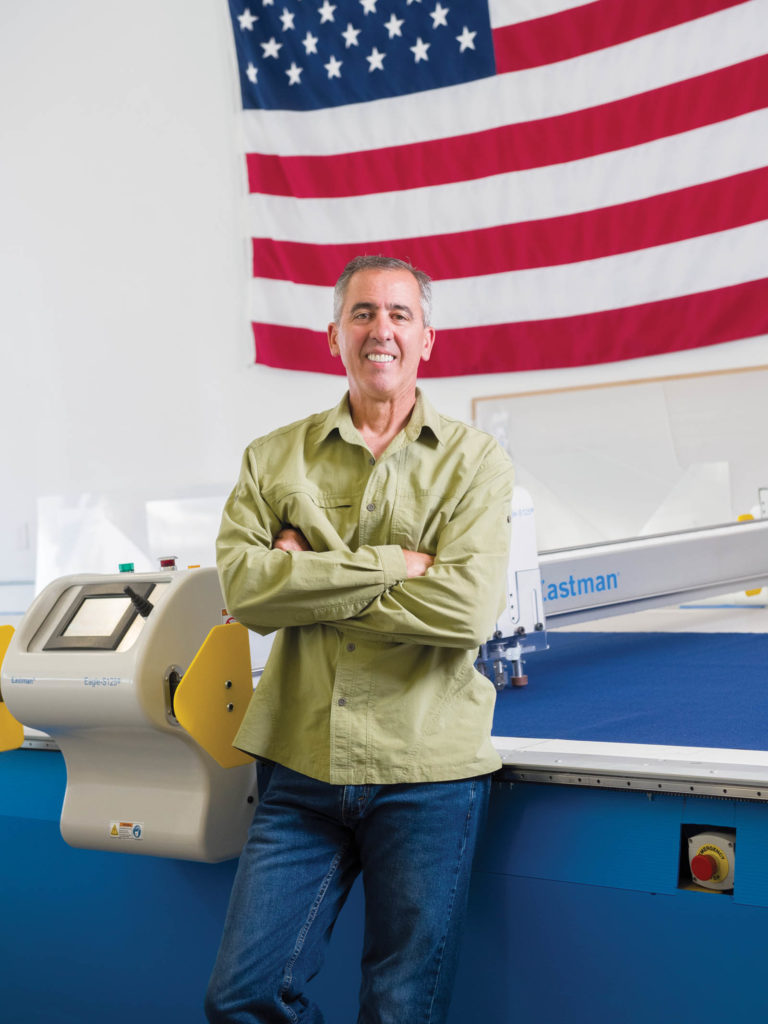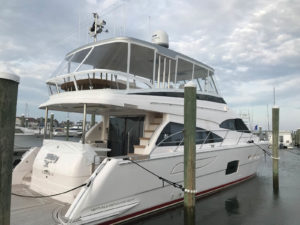By building his business slowly, Carl Pellegrini keeps SeaCanvas focused on quality, creativity and customer service.
by Jill C. Lafferty
Each project we accept is a new chance to make a change in the current design,” says Carl Pellegrini, the owner-operator of custom marine fabrication company SeaCanvas, based in Egg Harbor Township, N.J. “Let’s say an enclosure for a pleasure cruiser was originally just okay. We ask our clients how they use the boat and what they would be looking to change in their current design, and we take the time to explain our plan to make a final enclosure perfect for their boating needs. An enclosure or a cover or a full reupholstery for a boat has the chance to be just what the customer wishes for, and it only took our time asking questions.”
Pellegrini’s meticulous approach to his craft may be matched only by his meticulous approach to his business plan. He says his strong point as a business owner is to grow slowly and not put the company in a position where the need for more revenue is the reason to go to work each day.

“I may take time to make a business decision, but each major step forward is successful,” he says. “I will never feel like I should grow SeaCanvas quickly just to grow my business in my area, even though the opportunity might be there to have a larger shop. I like to take it in moderation.”
Pellegrini’s path to marine fabrication winds back to Philadelphia, Pa., where he was a commercial photographer in the 1980s. He enjoyed the work, but he started to tire of city life and began making frequent trips to the Jersey Shore to windsurf. Then came the fateful day when he received an ill-fitting bag for his windsurfing board from a mail order company. Frustrated, he walked two doors down from his studio to Keystone Sewing Machine Co. and asked owners Lois and Lenny O’Neill what kind of a machine he would need to make a board bag. One shop tour and $1,250 later, a new ConSew 206RB occupied a corner of his photography studio.
“I started a new company, which supplied the windsurfing industry with padded board bags and harness lines,” he says. “That company at one time won magazine awards for harness line design and exact-fit board bags.”
Other accolades included supplying harness lines to the Chinese windsurfing team for the 1996 Summer Olympics in Atlanta, Ga. But ironically, inexpensive imported Chinese softgoods were making it harder and harder to compete through the 1990s, he says. Then Pellegrini bought a boat, and he began meeting other boat owners who needed custom upholstery and canvas products. With his fabrication skills honed through the windsurfing business, SeaCanvas was born.
“Here I am, 19 years later, no longer taking pictures, except with my phone, and living by the shore,” he says.

Expanding and automation
For the company’s first eight years, Pellegrini operated SeaCanvas out of his home and his car, “working way too much, as we do as entrepreneurs,” he says. “Until a client at a marina on a Sunday evening told me I should be home with my family and not working. While that thought did change my work habits, it also said it was time to grow my business a bit.”
Pellegrini moved SeaCanvas out of his home and into a leased shop. More recently, the business purchased two side-by-side spaces with a total of 4,500 square feet for an office, showroom, workshop and storage. Seven years ago, he brought on an employee, Gladys Maxwell, who had previously owned an awning company with her husband. Every morning starts with a meeting between Pellegrini and Maxwell to plan out the work for the day.
“I’m really lucky to have a dedicated assistant who cares, and this caring comes from Gladys previously owning a small canvas business,” he says.
Pellegrini has considered adding another employee, but he has been able to delay that decision by moving the company in another direction: automation.
“A good friend of mine in the business, Darren Arthur [owner of Nautilux Custom Canvas of Hazlet, N.J.], finally got into my head about automation,” Pellegrini says. “I was so against this. I swore I would never buy a plotter cutter and other new technology for the industry.”
In 2016, Pellegrini conceded, purchasing a 7-by-28-foot Eastman cutting table and photogrammetry software to bring 2D plastic patterns into a CAD program, which breaks down all the needed parts and sends them to the cutting table.
“It was sort of like ‘WOW!’ What a lesson we had,” Pellegrini says. “Darren kept pushing me in this direction. I have to admit I put up a good fight to keep things old school. By the end of 2019 we will move into 3D to allow us to digitize a boat onsite in or out of the water without plastic patterns. Certainly a new challenge, but since I stepped into the 2D world, I now see how the next step of 3D is attainable for us.”
Customer satisfaction
When he is ready to hire a second employee, Pellegrini wants to ensure he can keep that person employed full time, 12 months of the year. SeaCanvas operates year-round, but its clients tend to only think about their boating needs in the spring, something Pellegrini wishes he could change.
“April, May and June, we just can’t get it all done at the same time and keep the quality up,” he says. “I want the quality to be at the highest end. I want every customer to be thrilled, and I don’t want anyone questioning what we’ve done.”
Pellegrini also wishes that his customers understood that every product that SeaCanvas fabricates is custom, and custom work takes time. “There are days where I wish we had a product on the shelf that just needs to be boxed and sent to the customer,” he says. “But that would not fulfill the appreciation we receive from our customers as we install a final enclosure or an upholstery job on their boat.”
While his professional path from commercial photographer to custom windsurf fabricator to marine fabricator may recall the path of a tacking sailboat, Pellegrini’s focus on creativity, customer service and measured growth have kept SeaCanvas on course.
“My background in arts and photography studies taught me to be meticulous about the thought process and the final outcome of each project,” he says. “Thinking this way leads to a high-quality product and a happy and satisfied customer.”
Jill C. Lafferty is associate editor of Specialty Fabrics Review and senior editor of InTents.
 Carl Pellegrini’s emphasis on customer relationships keeps clients coming back to SeaCanvas. “Late in 2018 we were asked by a long-time client to provide a full enclosure for his new 2019 Neptunus 65 vessel,” Pellegrini says. “We were excited about designing a complete bridge enclosure for his new boat.” The project involved replacing the existing enclosure with a new EZ2CY® enclosure. The enclosure is track at the top and snaps on the windshield. As the client did not want anything drilled into the windshield, the snap line was doubled.
Carl Pellegrini’s emphasis on customer relationships keeps clients coming back to SeaCanvas. “Late in 2018 we were asked by a long-time client to provide a full enclosure for his new 2019 Neptunus 65 vessel,” Pellegrini says. “We were excited about designing a complete bridge enclosure for his new boat.” The project involved replacing the existing enclosure with a new EZ2CY® enclosure. The enclosure is track at the top and snaps on the windshield. As the client did not want anything drilled into the windshield, the snap line was doubled.
The forward mid-window was real glass and flipped up, but it was too heavy and was replaced with a .080 EZ2CY window for ease of use. The aft enclosure below the midrail (track-to-track and split with zippers at the midrail) was solid fabric and was changed to EZ2CY for a clear view aft. One window on each side and the mid-aft and mid-forward windows flip up and are secured with Common Sense fasteners. To block the hot Miami sun, a zipper was added to the inside top of the enclosure and a full 75-foot four-piece curtain was installed. The customer says it keeps the bridge 30 degrees cooler. The result is a handsome enclosure designed with plenty of ventilation with flip-up windows. This project received an Outstanding Achievement Award in the Rigid Enclosures category in the 2019 Fabrication Excellence Awards, sponsored by the Marine Fabricators Association.
What advice would you give to someone interested in the marine fabrication business?
Work in the industry with a fabricator who understands your goals. Are you willing to be a part of their business down the road, or are you just there to learn and leave for your own interests? Being part of a business as a leader or manager could be just as fulfilling as being the business owner. Just be honest from the beginning. We are a complete custom industry. Upholstery for home or auto, or even home and commercial awning and shade sails, can be included in any shop’s complete business plan. Look toward a shop where there is growth, where you could be in a manager position or a position where you run one segment of the shop.
 TEXTILES.ORG
TEXTILES.ORG


